-

Ashraf Hanna at work in his Pembrokeshire studio. Photo credit: Richard Foot
It’s not very often that we are left speechless by an artist’s work, but this was our reaction when we first encountered Ashraf Hanna’s elegant sculptural forms a few years ago. We marvelled at the purity of form, the smooth and eloquent interplay of gentle curves and sharp lines, the subtle colouring and the dialogue between the forms which becomes as much about the spaces in between as the vessels themselves. His work takes you on an explorational journey, each piece, examining how scale, colour, texture and material impacts our perceptions of form.
Ashraf’s technical skills are second to none and the evolution of his work from pinch pot to finished form is awe-inspiring. His work is in the permanent collection at the Victorian and Albert Museum, the Fitzwilliam Museum in Cambridge and the National Museum of Wales to name but a few. Not surprisingly, the artist is held in high esteem by ceramicists worldwide and he is known for his generosity in sharing his skills through teaching and lectures as well as sharing his unique ingredients for his very own ‘Ashraf Hanna’ clay, used by potters worldwide.
As part of our ongoing series of artist features, we talk to globally acclaimed ceramic sculptor Ashraf Hanna about his work and his latest project for the Victoria and Albert Museum.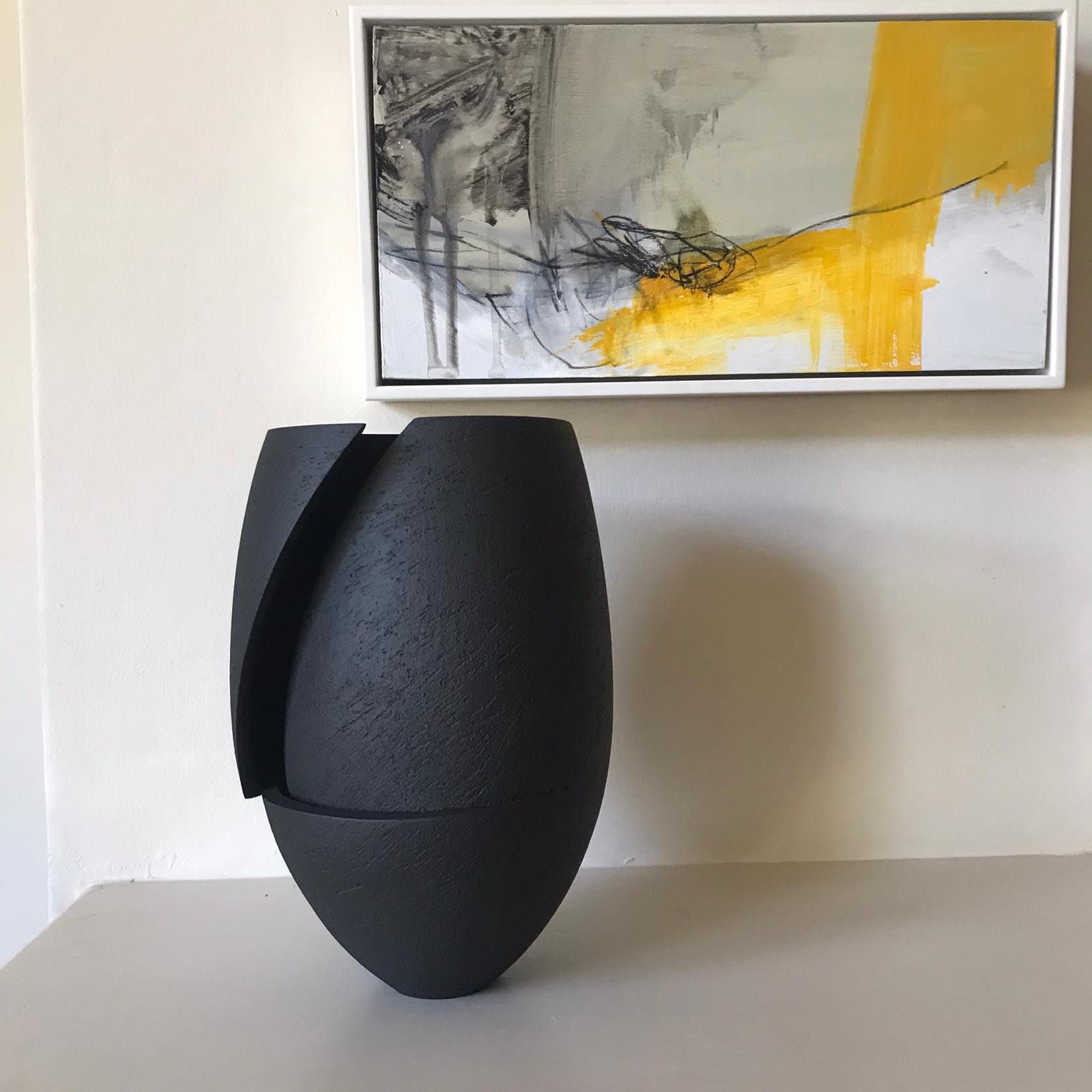
Ashraf Hanna: Black cut and altered vessel, stoneware, 21 cm H, 2020.
Shown here with painting by Angela Charles (sold)
CF: It’s amazing to think your pieces start life as a pinch pot, can you describe your method a little bit more?
AH: Pinching is the most basic way of making a pot. It was the first technique I was introduced to and despite having had a go at other methods, I loved the slow and contemplative nature of hand building, it suited my mindset.
Whether the form is a regular classic shape or an irregular one that evolves from one shape into another, the start is always through pinching a lump of clay either in the palm of my hand or on a banding wheel, the form is then developed and modelled by adding soft slabs after the base has dried and stiffened up enough to support the weight of the next layer. The forms I make undergo various stages of refinement before the final surface treatment with coloured, ultra-fine slips, called terra sigillata slips, that are sprayed on in between multiple firings.
Ashraf Hanna: White Undulating Vessel, 43cm H, stoneware, 2020
Burgundy Undulating Vessel, stoneware, 42cm H, 2020
CF: What themes do you explore in your work and how do your cultural roots influence you? You often talk about the influence of the Egyptian dunes on your undulating work and the Welsh landscape your Petrified Forest series, can you talk a little bit more about this?
AH: During the last 10 years or so, I have explored relationships between line form and material. I made a limited number of glass pieces which were well received. The dialogue between form and material is still an area of interest and one I hope to revisit at some point. In my Ceramic practice, I have been working on two or three bodies of work, installations which provide an opportunity to explore the impact of multiple objects in one composition, mainly within a site-specific context. The undulating forms with formal geometric bases and the cut and altered vessels both engage with the juxtaposition, intersections and movement of lines.
Ashraf Hanna: Installation of 10 vessels from the Petrified Forest Series (sold)
Growing up in Egypt, I was surrounded in my formative years by structures that spoke to me of scale, formal approaches in sculpture and beautifully crafted objects. The appreciation of those qualities has seeped into my unconsciousness along with the quiet beauty of an ever-changing sand dune, and the timeless flow of the River Nile.
My creative identity is however layered, I have now lived in the UK almost twice as long as I lived in Egypt. I handled clay for the first time here and, having lived in London then Pembrokeshire for the last 20 years, I have absorbed and tried to respond to new visual stimulants, not least the extraordinary forests and storm beaches. It is a very different environment from that of my younger years, in Egypt, we lived in the Nile Valley, which is just 6% of the entire area of the country, the rest is desert.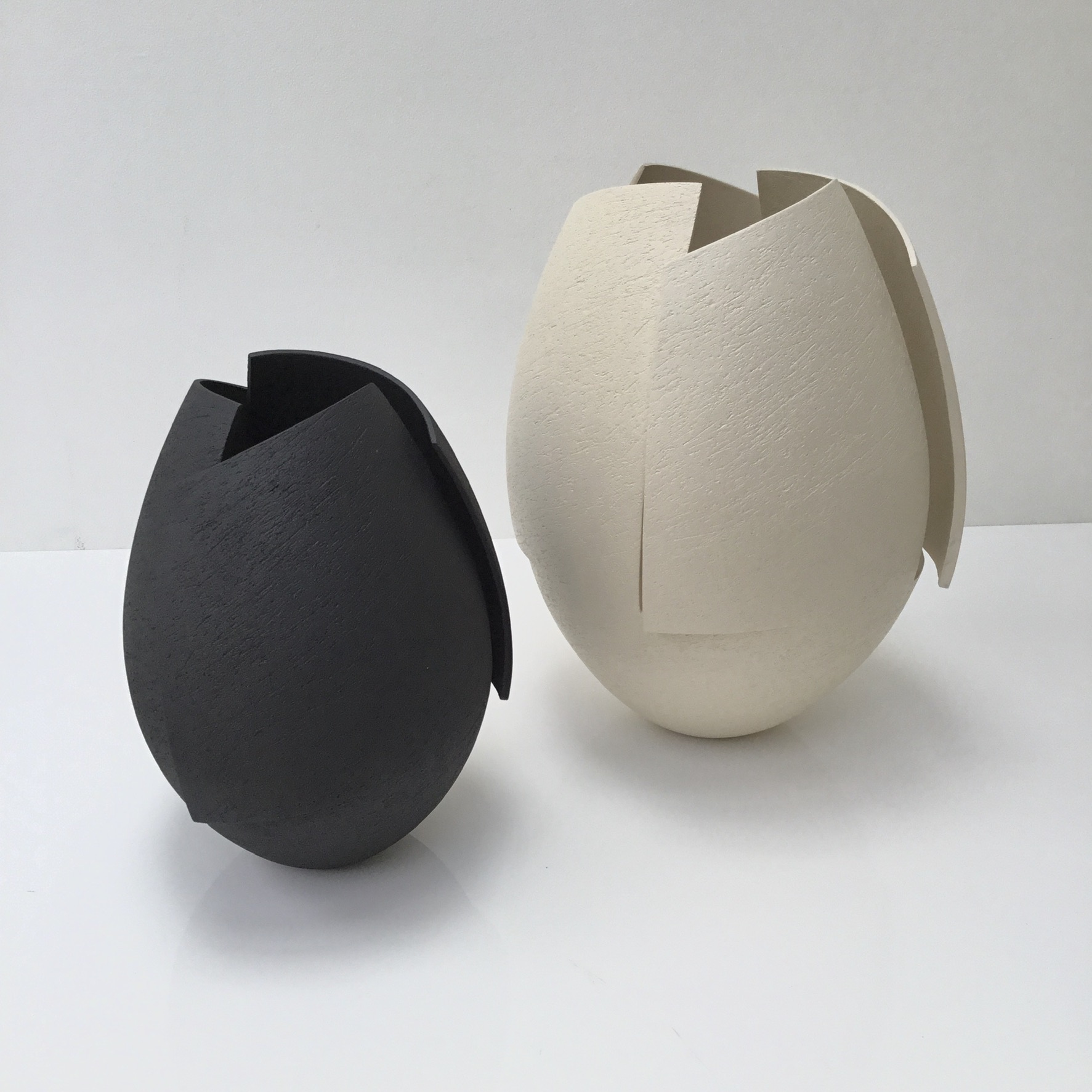
Ashraf Hanna: Black cut and altered vessel, 27 cm high, stoneware, 2020
Bulbous White Cut and Altered Vessel, 35cm H, stoneware, 2020CF: What relationship does colour have with form in your work? We know you have to undertake multiple firings to achieve your distinctive colours, is this meticulously planned or is there some element of chance involved?
AH: Colour is a powerful factor in determining our perception of objects but I am someone who thinks first and foremost in form, and as I was interested in a number of areas, I worked within a restricted monochrome pallet for a while to enable me to develop different forms. I have since started introducing colour to that palette. The choice of colour is reflective of either a personal experience or in response to a particular project. Yellow for instance is a colour that I associate with summer, happiness and energy.
A few years ago, my wife, Sue and my two little girls insisted that I should accompany them for a walk. It was a hot, sunny spring day and as we approached a corner, they asked me to close my eyes, held my hands and walked me on for couple of minutes. With my eyes closed, the other senses became heightened – I became aware of a sweet scent that was becoming more and more intense, I could hear the continuous humming of bees all around. The girls finally let go of my hands and asked me to open my eyes, I was overwhelmed by the impact of being engulfed in a sea of vibrant yellow as I found myself surrounded by what seemed like an endless rape field. Even on the darkest winter day, whenever the light catches the interior of one of my yellow pots it lifts my spirits and takes me back to that moment in the middle of the field.
I am increasingly asked to take on site-specific commissions where colour choices are crucial, this provides me with an opportunity to explore new palettes.
Ashraf Hanna: Black and Yellow Undulating Vessel (sold)
CF: Can you tell us a bit more about what you are working on at the moment?
AH: Currently I am working on an installation in response to a beautiful collection of Asyut pottery in the Victoria & Albert Museum in London. The project is the result of an encounter with Dr Mariam Rosser Owen, the curator of the Middle East department at the V&A where two of my undulating vessels are in the permanent collection. Dr Rossen Owen invited me to visit the museum to see a collection of burnished wares made in Asyut, a neighbouring province south of El Minia where I was born in Egypt. I was astonished to see this intricately carved, 19th century, burnished collection, which was made for export purposes to Europe. I had never seen anything like it whilst growing up in Egypt and this started a dialogue which ultimately led to an invitation to respond to that collection.
Ashraf Hanna exploring the collection of burnished pottery from Asyut which is housed in the V&A Museum, London. Image courtesy of Dr Mariam Rosser Owen
AH: In December 2019, I went back to Egypt to visit traditional potters working in Upper Egypt, in my home town El Minia and in Asyut to learn about their practice which has changed little in hundreds if not thousands of years. The outcome of this exploration will be part of an exhibition curated by Dr Rosser-Owen in a display of ‘Contemporary Ceramic Art from the Middle East’.
CF: How do you think your recent trip back to Egypt has enriched your work?
AH: The trip was important on a number of levels. I started working with clay in the UK, so I never had a chance to meet any Egyptian potters. My first-hand knowledge of Egyptian pottery was restricted to memories of the coarse terracotta water-cooling vessels and storage jars I grew up with. The objects used in still life compositions at drawing classes in El Minia college of Fine Art were the closest I got to observing pots within a creative context.
During my visit in December I went on a ceramic trail; whilst researching the origins of materials and techniques used in the Asyut wares was the main instigator for the trip, I did so within the context of discovering and acquainting myself with the wider ceramic ‘scene’ in Egypt, visiting potters, colleges and community projects. It’s an experience that will stay with me for a long time.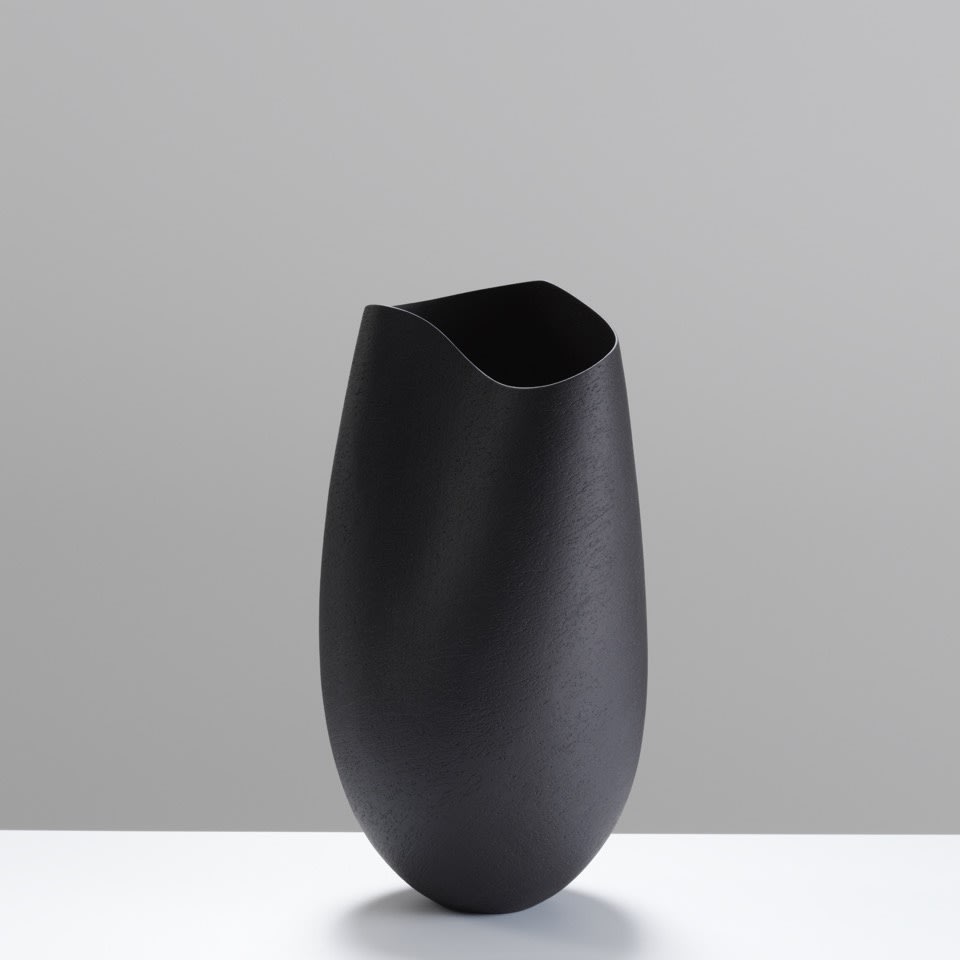
Ashraf Hanna: Small Black Vessel, Size: 37 H x18 W x 18 D, stoneware, 2018 (sold)
CF: You work on several bodies of work how do you know when you have achieved everything you want to achieve with a particular body of work?
AH: I have had a number of directions in my career to date. With any body of work, I am trying to develop two things, first is the idea, then, I work on the skills and technical knowledge needed to enable me to execute my ideas and effectively communicate them. I am a firm believer in thinking through making. New ideas are often conceived and developed throughout the making process. It is, however, important to maintain a disciplined approach to making so when ideas pop up whilst working on a specific piece, I doodle a drawing on my worktop, make notes and take images with a view of revisiting these ideas.
In an ideal world, we make first and foremost for ourselves. The decision to move on into a new direction does not necessarily mean that I am bored with what I am working on, it just means that I am more excited by something else!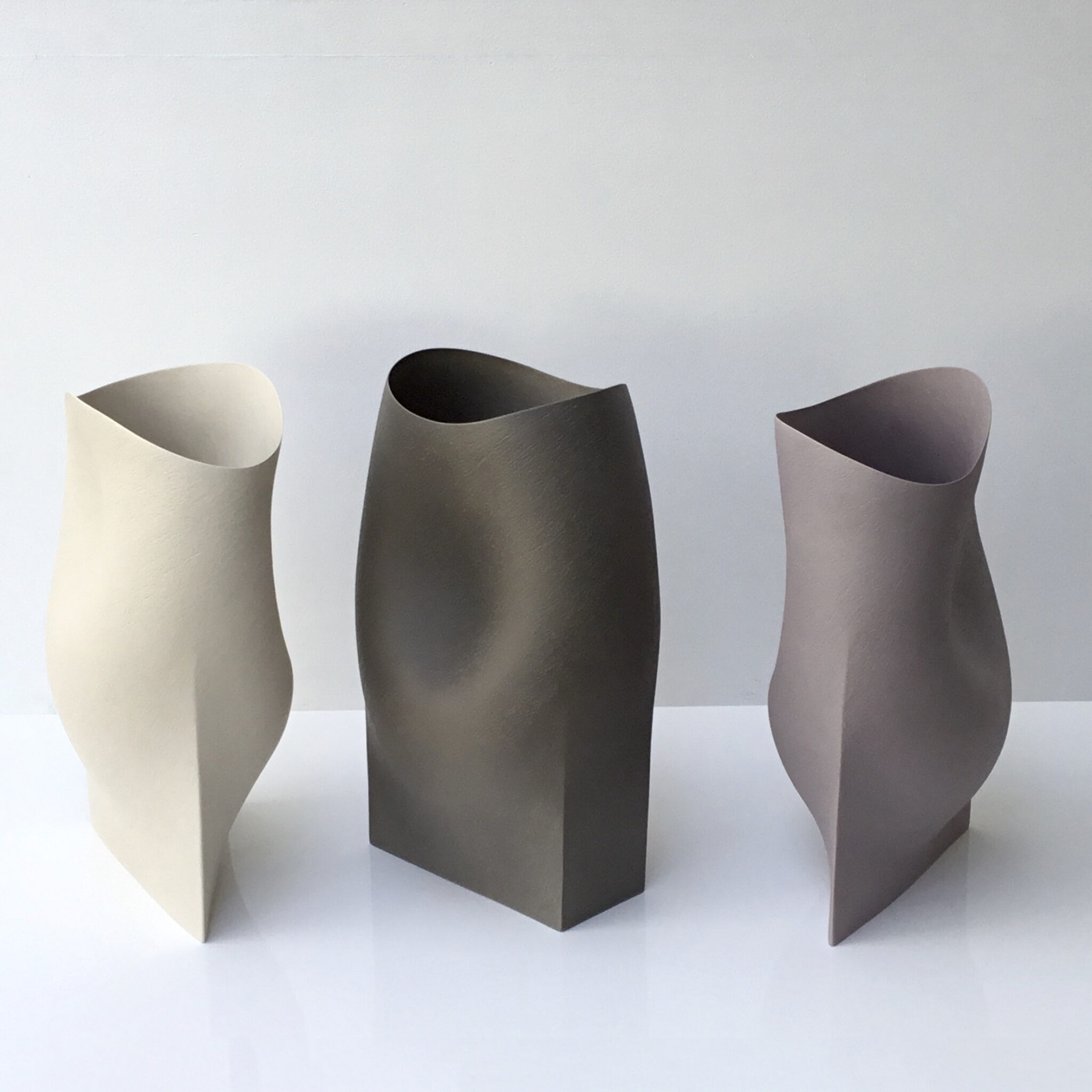
Ashraf Hanna: Group of Undulating Vessels, White, Grey and Lavender Grey 43cms H, stoneware, 2020
CF: You mentioned your wife Sue earlier, she’s an accomplished ceramic sculptor herself and was responsible for your introduction to ceramics, wasn’t she? What ongoing impact does her work have on yours and vice versa?

Ceramics by Sue Hanna : 3 saggar fired slim vessels, tallest height 35cm
AH: Yes, Sue introduced me to clay and taught me how to make my first pinch pot. Our first studio together was in Hackney in London back in 1999, we moved to our current home/studio in Pembrokeshire the following year in 2000. The most important contribution we made to each other’s work is having been able to engage in a creative dialogue for over 20 years. There are often moments of doubts and insecurity; as creatives, we are not detached from what we make; sometimes it is very useful to have feedback from someone who is aware of the personal as well as the professional aspect of one’s approach to work.
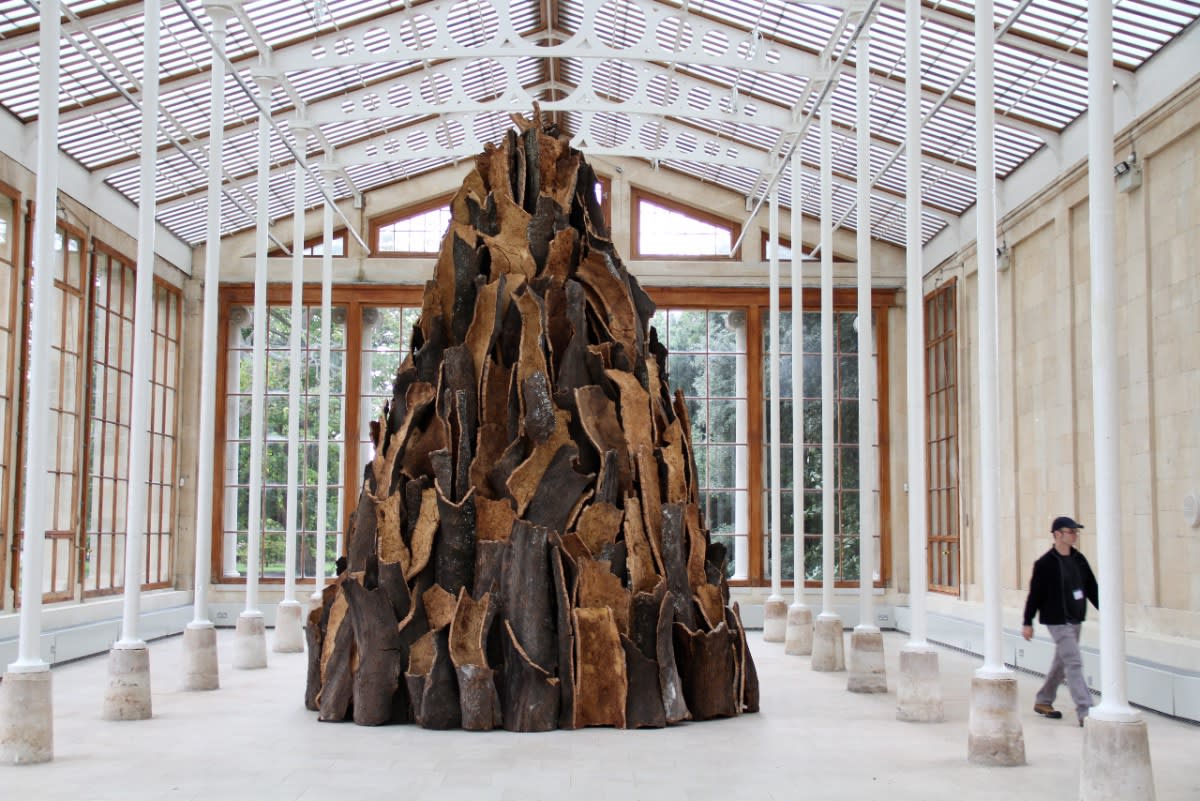
David Nash RA, Cork Spire 2012, Cork Bark, 500cm H, Kew Gardens
CF: Which artists inspire you?
AH: This is very difficult as I admire many artists for different reasons – but I love David Nash’s work – the idea of making a living sculpture excites me. His work engages with scale, texture and form in a bold and uncompromising fashion rooted in an awareness of his local environment, exploiting the different material qualities of wood as a living medium.
I also have to mention Hans Coper, he was the first potter I came across who made vessels then did something else with them, either altering or cutting and assembling different pieces together.
Ashraf Hanna: Bulbous White Cut and Altered Vessel, 35cm H, stoneware, 2020
CF: How has this period of lockdown influenced your work, if at all?
AH: It affected me on a very practical level, initially. The shutdown was very swift in the end which has meant that project I was working on was disrupted by inability to get supplies and by homeschooling our children. The V&A exhibition has now been postponed till later on in the year and I am now regaining the momentum, working through the various experiments and clay testing.
Actor James Nesbitt’s collection of Ashraf’s cut and altered vessels, as featured in last week’s FT How to Spend it article and shown here alongside work by Cavaliero Finn artists Gill Rocca and Nicholas Lees.
Find out More About Ashraf's Work